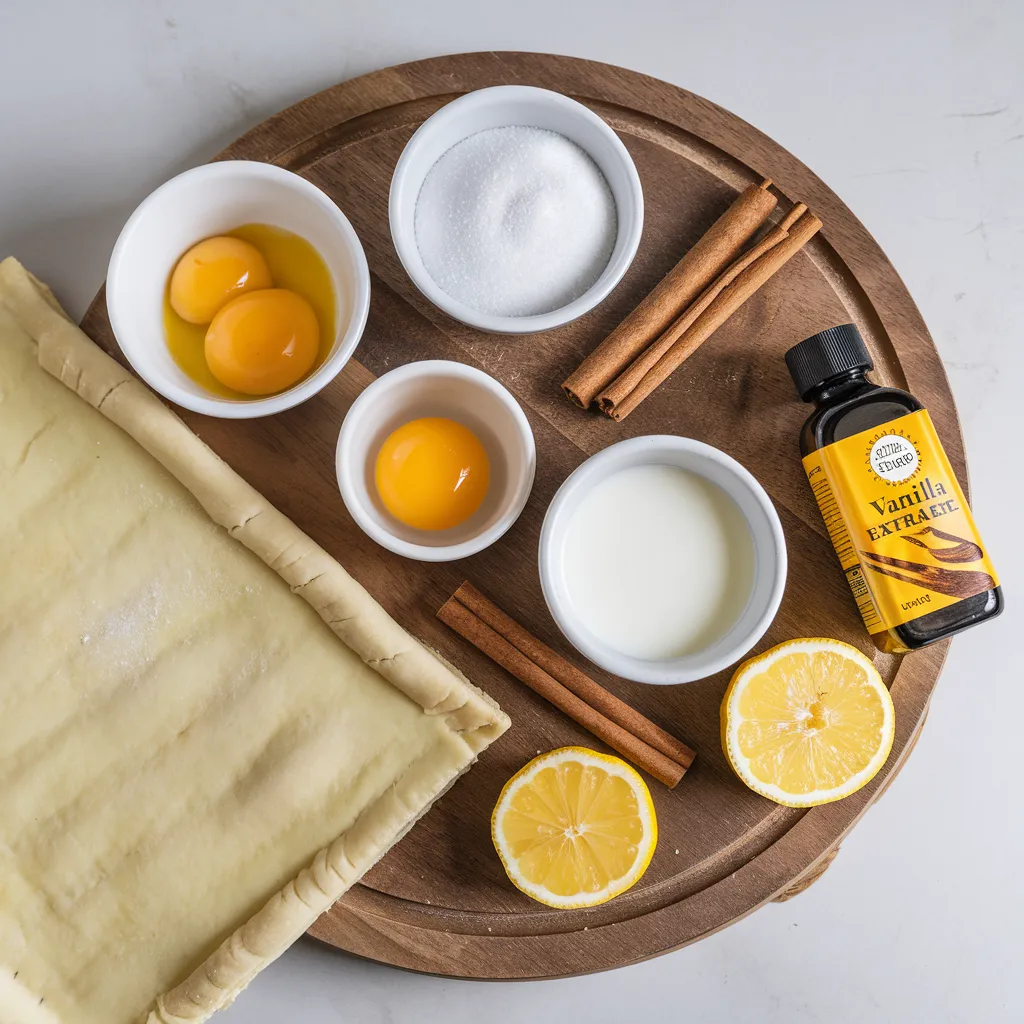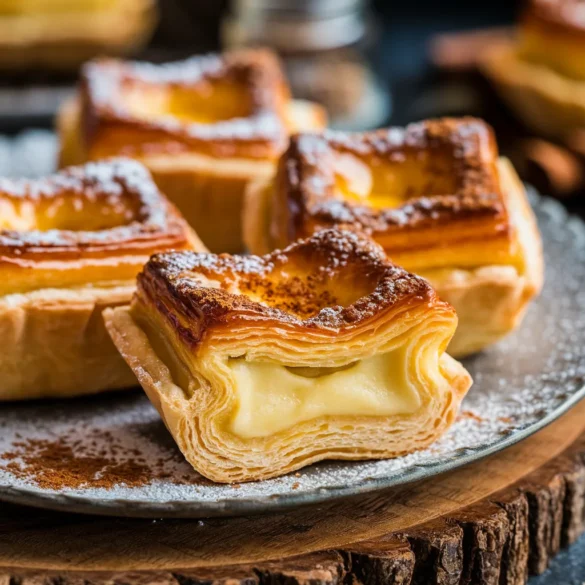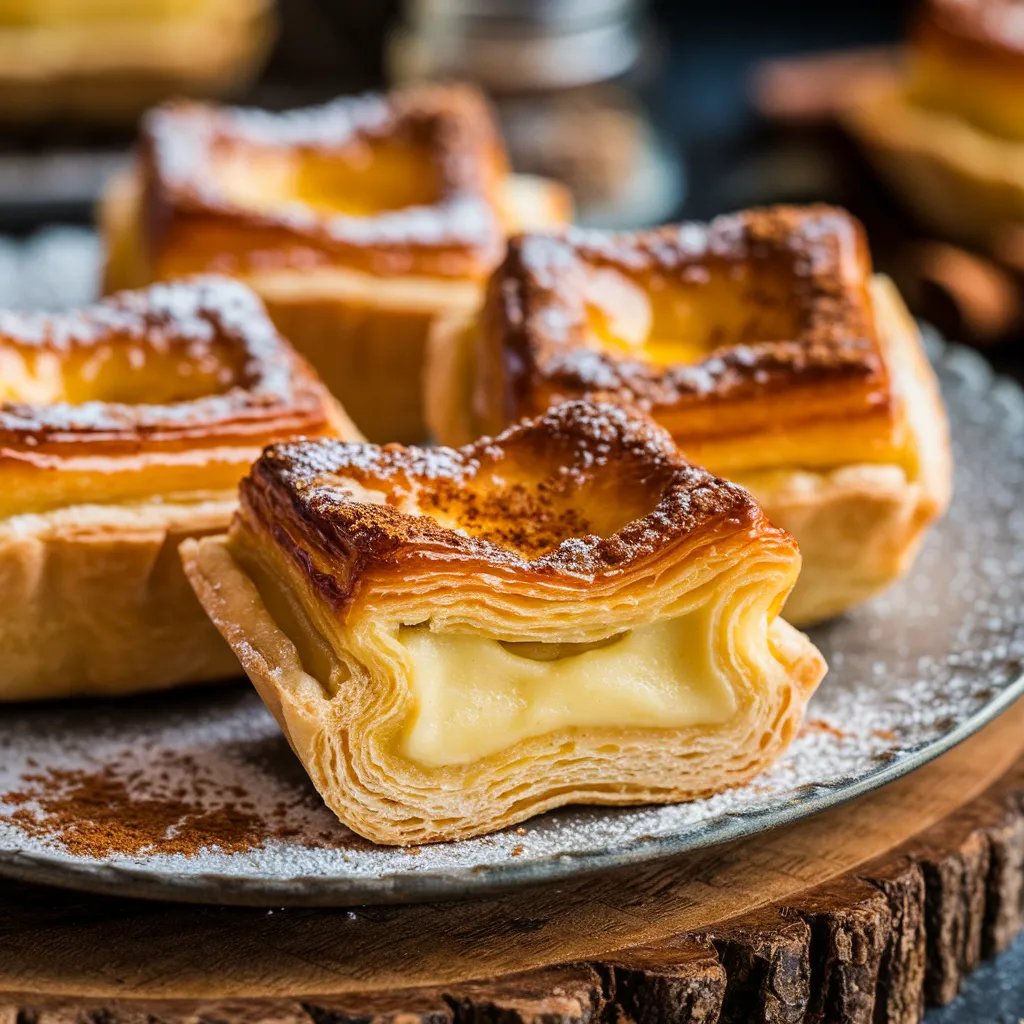The first time I tasted a Pastel de Belém in Lisbon, it was magical. The tart crumbled perfectly, showing a rich, creamy custard. It took me straight to Portugal’s historic streets. This pastry is more than a recipe; it’s a piece of cultural heritage for your kitchen.
Imagine making Lisbon’s beloved pastry at home. This guide will teach you to make these iconic treats. It’s perfect for both passionate bakers and curious food lovers. You’ll learn every step to make the perfect Portuguese egg tart.
Key Takeaways
- Discover the authentic technique for making traditional Pastel de Belém
- Learn the historical significance of this iconic Portuguese pastry
- Master the delicate balance of crispy pastry and creamy custard
- Understand the essential ingredients for an authentic recipe
- Explore the cultural importance of Pastel de Belém in Portuguese cuisine
The History Behind Pastel de Belém and Jerónimos Monastery
The story of pastéis de Belém is a tasty journey through Portuguese food history. It’s found in the heart of Lisbon. This famous custard tart recipe is filled with tradition and cultural importance.
The Secret Recipe’s Origins
In the early 19th century, monks at the Jerónimos Monastery found a clever use for egg whites. Sugar refineries used egg whites to starch clothing, leaving lots of egg yolks. Their smart idea became the belem pastry recipe that transformed Portuguese food forever.
- Monks created the recipe to avoid wasting food
- Egg yolks became the main ingredient in their soft custard
- The recipe was kept secret for many years
From Monastery to Famous Pastry Shop
After the monastery closed in 1834, a sugar refinery worker got the secret recipe. In 1837, he opened the famous Pastéis de Belém bakery. He introduced the world to this amazing Portuguese treat.
“A taste of history in every bite” – Local Lisbon saying
Cultural Significance in Portuguese Cuisine
Today, pastéis de Belém is more than a sweet snack. It stands for Portuguese food innovation, cultural pride, and turning simple ingredients into amazing dishes.
People from all over the world wait to try this legendary pastry. It’s a true food landmark in Lisbon.
Essential Ingredients for Authentic Pastel de Belém Recipe
Making the perfect lisbon pastry needs careful picking of top-notch ingredients. These ingredients bring the heart of Portuguese bakery traditions to life. The secret to conventual confectionery is in mixing simple yet amazing parts.

To make a real Pastel de Belém, you’ll need these key ingredients:
- Puff Pastry
- All-purpose flour
- Cold unsalted butter
- Salt
- Ice-cold water
- Custard Filling
- Egg yolks
- Sugar
- Whole milk
- Heavy cream
- Cornstarch
- Cinnamon stick
- Lemon zest
The secret to a great Portuguese egg tart is in the ingredients. Fresh egg yolks from free-range chickens make the custard bright and rich. High-quality butter in the puff pastry makes it flaky and delicious.
Choose ingredients that are fresh and true to their origins. Local Portuguese ingredients will make your lisbon pastry truly special. If you can’t find exact Portuguese items, find high-quality substitutes that keep the traditional taste.
“In conventual confectionery, every ingredient tells a story of tradition and craftsmanship.” – Portuguese Culinary Expert
Tools and Equipment You’ll Need for Portuguese Egg Tarts
To make authentic pastel de belém, you need more than ingredients. The right tools are key to getting that perfect texture. Whether you bake at home or love cooking, picking the right equipment is important.
Traditional Baking Tools
Traditional Portuguese kitchens use special tools for pastel de belém. Here are the must-haves:
- Copper mixing bowls for custard preparation
- Wooden spoons with long handles
- Clay or ceramic baking dishes
- Vintage cast-iron ovens
Modern Kitchen Alternatives
Not everyone has traditional equipment. But, modern tools can help you make jerónimos monastery recipe:
- Non-stick metal mixing bowls
- Silicone spatulas
- Digital kitchen scales
- Convection ovens with precise temperature control
Pastry Molds Selection Guide
Choosing the right pastry molds is essential for great pastel de belém. Consider these factors:
- Size: Standard Portuguese egg tart molds are 2-3 inches wide
- Material: Aluminum or non-stick metal is best
- Depth: Shallow molds, about 1 inch deep, are traditional
- Surface: Look for smooth, even surfaces for even baking
With the right tools and equipment, you’ll make delicious Portuguese egg tarts. They’ll be as good as those in famous bakeries.
Preparing the Perfect Puff Pastry Base
Making an authentic portuguese egg tart begins with a great puff pastry base. This base is key to the tart’s flaky texture. It’s what makes custard tart recipes stand out.
To make your puff pastry, focus on a few important steps:
- Use cold butter for flakiness
- Fold the dough to create layers
- Chill the pastry between folds
- Roll it thinly for crispiness
If you’re in a hurry, store-bought puff pastry is a good choice. Choose all-butter varieties for the best taste and results.
Temperature control is critical for perfect puff pastry. Keep your dough cold and work fast to avoid melted butter. Roll out the pastry gently to keep those layers intact. This will give your tart a crisp base.
Pro tip: Always let your pastry rest in the refrigerator for at least 30 minutes before shaping and baking to ensure the best possible texture.
Creating the perfect puff pastry base takes practice. Don’t worry if it’s not perfect at first. Even experts keep improving their skills.
Creating the Signature Custard Filling
The heart of any Lisbon pastry is its custard filling. Making the perfect belem pastry recipe needs precision and traditional techniques. Your custard will turn simple ingredients into a masterpiece that shows the true taste of Portuguese baking.
Professional bakers know that the custard’s success comes from the right ingredients and careful preparation. Authentic pastéis de belém use fresh egg yolks, quality milk, and just the right amount of sugar. Your goal is to make a smooth, rich filling that fits perfectly in the crisp puff pastry shell.
Mastering the Custard Consistency
To get the right texture, heat gently and watch closely. Whisk your egg yolks and sugar until they’re pale and creamy. Then, slowly add warm milk to avoid curdling, making a silky mix that sets well when baked.
The secret is smooth, consistent stirring to avoid lumps.
Temperature Control Tips
Temperature is key for the perfect custard filling. Use a kitchen thermometer to keep the mix between 160-180°F. This range is safe and keeps the custard’s delicate texture special.
Take it off the heat when it starts to thicken. Let the remaining heat finish cooking it.
Achieving the Perfect Sweetness
The perfect belem pastry recipe balances sweetness with a hint of complexity. Use top-quality cane sugar and add a bit of vanilla or lemon zest for extra flavor. Taste and adjust the sweetness to your liking, aiming for a delicate, not too sweet, taste.
FAQ
What are Pastéis de Belém?
Pastéis de Belém are traditional Portuguese egg custard tarts. They come from the Jerónimos Monastery in Lisbon. The tarts have a crispy pastry shell filled with creamy custard. They’re served warm, dusted with sugar and cinnamon.
How different are Pastéis de Belém from regular Portuguese egg tarts?
Pastéis de Belém are similar but have a secret recipe. The original recipe from Lisbon’s Fábrica dos Pastéis de Belém is unique. It has a delicate texture and flavor.
Can I make Pastéis de Belém at home?
Yes, you can make them at home. But, it takes practice to get the authentic taste. You’ll need puff pastry, egg yolks, sugar, milk, and a hot oven.
What type of pastry is used in Pastéis de Belém?
They use a thin, crispy puff pastry. It’s hand-stretched to create layers. This makes the tart crisp and flaky.
Where can I find the most authentic Pastéis de Belém?
The original Fábrica dos Pastéis de Belém in Lisbon is the best place. It’s near the Jerónimos Monastery. They’ve been making them the original way for over 180 years.
Are Pastéis de Belém served hot or cold?
They’re best served warm. Dusting them with sugar and cinnamon before serving enhances the flavor. It contrasts well with the crispy pastry.
What makes the custard in Pastéis de Belém unique?
The custard is unique because of its preparation and ingredients. It uses egg yolks for a rich filling. The recipe balances sugar, milk, and eggs perfectly.
Can I freeze Pastéis de Belém?
You can freeze the pastry shells or custard separately. But, they’re best enjoyed fresh. Freezing and reheating can affect the pastry’s texture and custard’s smoothness.

Ingredients
For the Custard:
- 1 cup whole milk
- 1 cinnamon stick
- 1 lemon peel (just the yellow part, no white pith)
- 3 tbsp cornstarch
- 1 cup heavy cream
- ½ cup granulated sugar
- 4 large egg yolks
- 1 tsp vanilla extract
For the Pastry:
- 1 sheet of puff pastry, thawed
- 2 tbsp butter (for greasing the tin)
Instructions
-
Prepare the Custard:
- In a saucepan, heat the milk with the cinnamon stick and lemon peel over medium heat. Do not boil.
- In a separate bowl, mix cornstarch with heavy cream and sugar.
- Remove the lemon peel and cinnamon stick from the milk, then slowly whisk in the cream mixture.
- Cook on low heat, stirring constantly, until thickened.
- Remove from heat, let cool slightly, then whisk in the egg yolks and vanilla extract.
-
Prepare the Pastry:
- Preheat the oven to 475°F (245°C).
- Lightly butter a muffin tin.
- Roll out the puff pastry and cut it into 12 circles.
- Press each pastry round into the muffin tin, ensuring the sides are covered.
-
Fill & Bake:
- Spoon the custard into each pastry cup, filling them about ¾ full.
- Bake for 20–25 minutes until the tops are caramelized and the pastry is golden brown.
-
Serve & Enjoy:
- Let the tarts cool slightly before removing them from the tin.
- Sprinkle with powdered sugar and cinnamon before serving.
Notes
- For an authentic taste: Use high-fat dairy for the creamiest custard.
- Want extra caramelization? Broil for 2-3 minutes at the end of baking.
- Storage: Best enjoyed fresh but can be refrigerated for up to 2 days.

